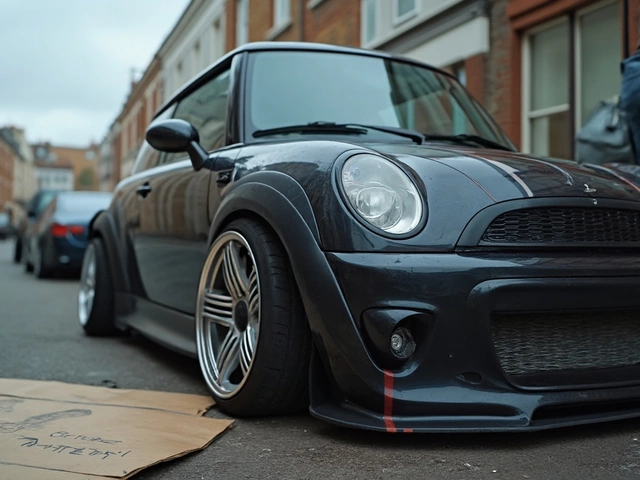If you pop the hood at a car meet, you’ll spot all kinds of mods—but one of the most popular starts where you’d least expect: right at the springs. Ask ten drivers how many inches lowering springs will drop their car, and you’ll get as many answers. Some say an inch, some shout three. Is it really just a matter of swapping out a few coils, or is there more behind that slammed look every car enthusiast craves? The truth is, lowering springs play by a tricky set of rules—sometimes, even the same set of springs can drop two cars by different amounts. Crazy, right?
How Lowering Springs Actually Lower Your Car & What Impacts the Drop
Let’s throw away the guesswork. Most mainstream lowering springs are designed to drop ride height by 1 to 2.5 inches. Brands like Eibach and H&R make their bread and butter on this range—1.2" on average for daily drivers, reaching as much as 2.5" for folks chasing that track-ready vibe. But here’s where things get interesting: how much your car drops depends not just on the spring, but on a medley of things including make and model, original suspension setup, the weight of modifications (big wheels, sound systems, even a half-tank of gas), and whether your car’s factory suspension was already worn and saggy. It’s never cookie-cutter.
Some cars, especially performance models or those with factory sport suspensions, might not drop as much as advertised because they’re already sitting pretty low from the factory. For example, a VW Golf GTI with a stock sport setup will see less drop than a base Golf using the same kit. On the other hand, family sedans or older, squishy rides might get a bit more than what’s quoted on the box. And don’t forget, lowering more than about 2.5 inches starts asking a lot of your stock shocks and bushings, so you’re rolling the dice on comfort and handling unless you upgrade those too. Ever see a slammed car bounce over bumps like it’s on a pogo stick? That’s what happens when you go too far without dialing in other parts.
Here’s something you don’t see on product pages: cold, hard numbers from real-world installations. In a 2023 enthusiast poll, folks reported average measured drops (after springs settled for 500+ miles) looked like this:
| Spring Brand | Advertised Drop (Front/Rear) | Measured Drop (Front/Rear) | Car Model (Example) |
|---|---|---|---|
| Eibach Pro-Kit | 1.3" / 1.0" | 1.1" / 0.9" | Honda Civic (2022) |
| H&R Sport | 1.6" / 1.4" | 1.4" / 1.2" | VW Golf GTI (2021) |
| Tein S.Tech | 1.5" / 1.2" | 1.7" / 1.3" | Subaru WRX (2020) |
| OEM+ (Dealer) | 0.8" / 0.8" | 0.6" / 0.7" | Toyota Camry SE (2023) |
This table doesn’t lie: measuring actual drop is the only way to know for sure. Even the best springs see about 0.1–0.3 inches less drop than they promise, especially once you factor in bushings, alignment changes, and daily carry weight. If you want that exact stance, leave yourself some wiggle room with expectations, especially on newer cars where tolerances are tighter than ever.

Choosing the Right Drop: Pros, Cons, and Common Mistakes
First thing: slam it too low, and you’re in high spirits until you meet your first speed bump or pothole. That sweet spot? Depends on what you use your ride for. If your commute is full of busted concrete and steep driveway lips, shooting for a moderate 1–1.5" drop keeps things practical, yet visually sharp. Drop closer to 2 inches and up, and style starts to outweigh practicality—you risk scraping your undercarriage, camber wear on expensive tires, and sometimes, kissing your oil pan goodbye. Nothing says “enthusiast regret” like calling a tow truck because your car ate a dip at the mall parking lot.
Here's what most folks miss: every single inch you drop cuts into your suspension travel. That means less room for the shocks to absorb bumps. The problem gets worse with cheap spring kits, which usually sacrifice coil density for looks. Think of it like this: stiffer, well-made springs can control bounce better, while bargain brands just make your car uncomfortable and can even make it handle worse. Pay attention to spring rates—the numbers are usually on the tech sheet. Don’t want to spend half your time sideways in the rain? Balance your drop with quality.
After swapping springs, always get a four-wheel alignment. The suspension geometry changes, so toe and camber will be off. Ignore this, and your fancy low profile tires might last half a season. The other tip most DIYers forget: let your springs settle for at least 500 miles before measuring drop and getting that first alignment. Springs compress even more as they break in—sometimes up to another 0.2 inches. Don't be the guy who aligns twice for no reason. If you want to maximize both stance and handling, consider upgrading to performance shocks or struts at the same time. Stock dampers usually can't keep up, especially on harsher drops. That’s why some spring brands include matched shocks for the full package.
And yeah, you can go even lower with coilovers, but those are a different animal—more expensive and not as ‘set-and-forget’ as springs. If you’re not tracking regularly, or don’t want to be tweaking height every other weekend, lowering springs are a simpler route. But like any mod, do the homework on your specific ride. Lowering a Civic isn’t like lowering a Mustang. Chassis, wheelbase, and even tire size all change the game.

Practical Tips for Measuring, Installing, and Living With Your New Ride Height
First, measure your current ground clearance from a known spot like the lowest pinch weld or front subframe. Do it before you wrench anything. That way, when you drop the car on new springs, you have a comparison. Trusting ‘the eye test’ often leads to disappointment, especially since the change looks subtle at first. Here’s a simple at-home method: park on level ground, measure from the wheel center to the fender (both front and rear), and write those numbers down. Repeat after installation and again after a few hundred miles. You’ll know exactly what changed.
Spring installation is within reach for most weekend warriors, if you have a decent set of tools and a spring compressor. But messing with compressed springs is no joke. Always secure springs properly—a loose coil can shoot out with violent force. Watch installation tutorials for your car specifically. Marking old spring positions helps line things up on the reinstall, minimizing weird noises later on. If it’s your first time, buddy up with someone who’s done it before. Beer bribes usually work. And if you feel lost halfway, there’s no shame in getting a pro to finish. Safety (and your knuckles) come first.
- Wear safety goggles and gloves—seriously, accidents are more common than you think.
- Use anti-seize on all bolts for easier removal later.
- Double-torque all suspension bolts after driving 100+ miles once things settle.
- Don’t forget to check clearance inside the wheel well. New springs and shocks can sometimes rub with wider aftermarket wheels.
- After installing, drive cautiously at first. Listen for clunks or rattles. If you hear something odd, check it out ASAP rather than waiting for the next oil change.
Lifestyle changes might surprise you, too. Lowering means recalibrating your approach to steep entrances, particularly if you’re loaded with friends or cargo. It’s also worth noting: alignment specs for lowered cars differ from stock—most shops will know this, but it’s smart to ask. Keep an eye on tire wear the first few months. Odds are, with the right drop and setup, you’ll be grinning on every onramp and barely noticing the firmer ride. Ride comfort drops slightly below what you had before, but sharp handling and improved stance are usually worth it. If you’re worried about ride quality for daily use, choose progressive springs over linear types—they cushion small bumps better while controlling roll in corners.
To sum it up in the realest way: lowering springs, when picked with care and installed right, are still the best gateway into performance car culture. They drop you anywhere between 0.8 and 2.5 inches, but the real result is how much they change your relationship with your car—turning every drive into something worth talking about.




